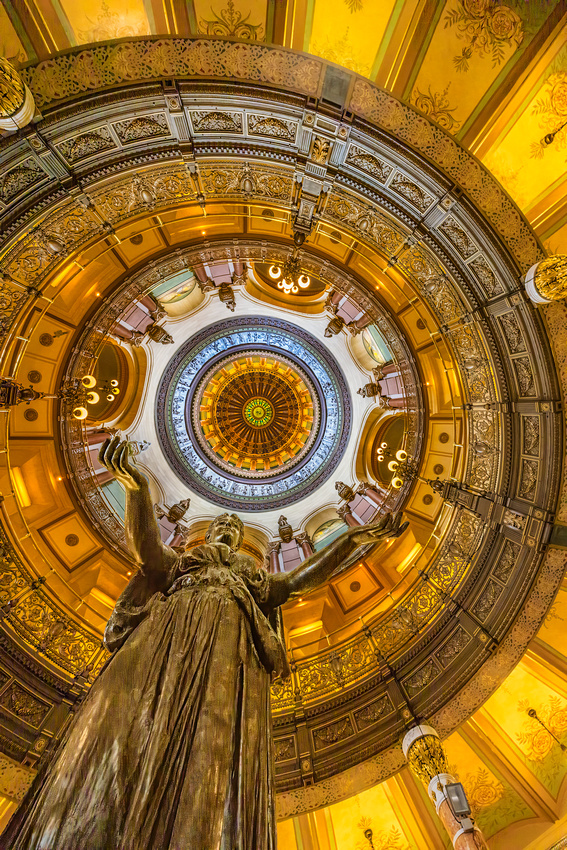Welcome to the landscape photography blog by Chuck Derus. Thanks for looking and for your comments!
The Season with Two Names


Summer is over and winter hasn’t yet arrived. Do you call this season autumn or fall? And why does it have two names?
The names of our two extreme seasons, winter and summer, are very old words. The reconstructed Proto-Indo-European (PIE) language originated from around 4500 BCE to 2500 BCE in Eastern Europe and Central Asia.
Summer comes from the PIE root sem, which means half. This suggests that in Europe, there were originally only two seasons. The root sem transformed into many similar words such as sumor, sumar, and somer.
Winter comes from the PIE root wed, which means water, wet, or rainy. It was similarly transformed with the English word winter coming from the Proto-Germanic wintruz.
The other two seasons are relatively recent additions. There were no distinct English words for spring or fall until the 16th century.
Descriptions of springtime first appeared in Early Modern English, from the 14th to the 16th centuries. Numerous words such as vere, primetide, and lenten described springtime. According to Earl R. Anderson in his book Folk Taxonomies in Early English, this variety of terms suggests spring was unimportant compared to winter and summer.
The same applies to fall. It was sometimes described as the time for harvest, but harvest referred to an activity and not to a season.
Autumn first appeared in English around the late 14th and early 15th centuries. It coexisted with harvest as a loose description of the season for another 200 years.
Fall first shows up in the mid-16th century in England as the fall of the leaf, which was shortened to just fall. Like harvest, it was descriptive. But it also evoked a poetic sense of what made this season different.
The recognition of fall/autumn as a distinct season started in England at the same time the American colonies began to separate linguistically from British English.
Noah Webster, of Webster’s Dictionary, was an ardent spelling reformer. His work was sensible and logical (center instead of centre, for example). But he was also politically motivated to differentiate American English from British English. By the mid-19th century, Americans commonly used fall and the British commonly used autumn.
The Shot
Last week, friend and fellow photographer Jon Christofersen and I walked into the Hovland Woods Scenic and Natural Area near Grand Marais, Minnesota. We were in search of fall color.
The Woods are home to over a dozen native plant communities. Aspen-birch forest blankets roughly half of the 1,280 acres. Because nearby Lake Superior moderates the climate affording cooler summers, milder winters and higher humidity, a sugar maple hardwood forest can exist there.
After a pleasant hike, we arrived at the sugar maple forest. We had the occasional reds we were looking for to compliment the vibrant yellows, oranges, and greens of other leaves and the blue of the sky.
Pointing our cameras upwards and using the edge of a tree to produce a sun star, we rejoiced in being there and in capturing some of Minnesota’s beauty.
Thanks for looking,
Chuck Derus
Rakaposhi


Last looks are often memorable. This one is forever etched in my memory.
It was November 11, 2023, our last evening of photography in Pakistan. I was standing with our photography group on the side of a dirt road just outside the remote village of Chaprot at over 9,000 feet above sea level.


There was a chill in the air. It was late fall, and when the sun dipped behind the ridge to our right, my jacket and hat provided me with a soothing warmth.
We peered into a picturesque valley and off into the distance. A small stream served as a striking photographic leading line transporting the viewer to a distant, compelling mountain peak.
It was Rakaposhi. The sight commanded our rapt attention. The mountain is simply spellbinding.
It’s the only peak on earth that descends directly and without interruption for almost 20,000 feet from its summit to its base. Rakaposhi is also the only mountain in the world rising directly from beautifully cultivated fields to its dizzying height of 25,550 feet.
It’s a tough climb. The first successful recorded ascent wasn’t until 1958 by Mike Banks and Tom Patey, members of a British expedition. It took another 21 years before the second team reached the summit in 1979.
If you decide to climb Rakaposhi, base camp is a record 16,400 feet below the summit. Every other tall mountain in the world has a shorter climb from base camp.
The Shot
We waited until the sun kissed just the top of the peak. I’m sure I looked less than graceful taking the picture. Placing the tree on the left in the ideal part of the frame required me to stand on my tippy toes on a small rock near the edge of a drop-off with the camera held as high as possible over my head.
It took several attempts before everything was in the frame and level. You’re probably laughing, but you try it!
We just stood in admiration as the mountain gradually lost its illumination. Finally, it was time for high fives, handshakes, and hugs as we reluctantly concluded our trip and prepared to start the journey home.
The downhill drive out of Chaprot to the highway took several long hours on a sketchy dirt road. It was several more hours until we arrived at our hotel for a good night’s sleep. But Pakistan was worth every minute of our arduous travels.
If you want to see a 39-second video of the start of our drive back to the hotel, it’s at Zenfolio | Chuck Derus | Pakistan
I’m on vacation for the next few weeks, so the next Friday Photo won’t be until October 11.
Thanks for looking,
Chuck Derus
Home of the Vulcans


Vulcans are the fictional extraterrestrial species in the Star Trek franchise. Noted for their pronounced eyebrows, pointed ears, strict adherence to logic, and a distain for emotion, they are from the fictional planet Vulcan.
The most notable Vulcan is Spock. He was first played by actor Leonard Nimoy in the original 1966-1969 TV series Star Trek. The three-year, eighty-episode series inspired an additional fourteen TV series and an equal number of movies.
Star Trek is a 2009 motion picture prequel to the original TV series. The 11th film in the franchise was written as a reboot that spawned two sequels. It featured the main characters of the original TV series portrayed by a new, younger cast.


Swell Times
If you watch the movie, you'll be seeing Utah scenery. Scenes of Spock's home world Vulcan were shot in the San Rafael Swell. It’s the same San Rafael Swell from last week’s Friday Photo.
The movie crew spent five days filming in the Swell. This wild country of barren rocks, dagger-like peaks, and hidden canyons made for a perfect alien planet.
Watch the scene where Spock witnesses the antagonist Nero destroy Vulcan. You’ll see the silhouette of the San Rafael Swell peaks disappear into the misty distance.
The Shot
In March of 2023, friend and fellow photographer Jon Christofersen and I hiked into the Swell’s Ding and Dang canyon trail. After scrambling a hundred feet up to a ridge, we launched our drones and started exploring.
I began looking west, but when I turned east and saw the rising sun, I knew I had my shot.
The next Friday Photo will be September 20. I’m taking next week off.
Thanks for looking,
Chuck Derus
Land of Lincoln


At age 23, with no real qualifications and limited formal education, Abraham Lincoln ran for his first Illinois political office. Following an initial loss in 1832, Lincoln subsequently served four terms in the Illinois House of Representatives.
In 1836, after borrowing and reading books on the law, he received his Illinois law license. On April 15, 1837, Lincoln moved to Springfield, Illinois, to practice law with John Todd Stuart.
It’s also where he met Mary Todd. In the fall of 1842, they decided to marry despite the opposition of Mary’s family.
He set his sights on the U.S. House of Representatives and was elected to his only term there in 1846. In January 1849, before his term ended, he proposed an amendment to abolish slavery in the District of Columbia. When his term ended, he returned to Springfield.
In 1854, Lincoln won a fifth term in the Illinois House of Representatives but decided to run for the U.S. Senate instead. He lost to Stephen A. Douglas.
Then came the Republican National Convention of 1860 and the rest is history. On a rainswept morning of February 11, 1861, Lincoln left for Washington, D.C. He did not return until May 4, 1865, when his funeral train’s somber journey finally ended in Springfield.
Sight Seeing
Last week, my wife Christine and friends Deb and Win Wehrli visited Springfield and the Illinois State Fair. Our first afternoon found us visiting the Illinois Capitol Building, the Illinois Supreme Court building, the Lincoln Presidential Museum, and Frank Lloyd Wright’s Dana-Thomas House.


Me, my wife Christine, Deb Wehrli, and Win Wehrli
Coming from Minnesota, this was my first visit as a tourist to Illinois’ capital. In the late 1990s, I made several work trips to the Capitol building to “work the rail” lobbying legislators in my former role as chair of the Illinois Association of HMOs Medical Directors Commission.
What captivated my attention last week was touring the Illinois State Capitol Building. I kept imagining a young Lincoln honing his political skills in that very building.
His words came to mind. “As I would not be a slave, so I would not be a master. This expresses my idea of democracy. Whatever differs from this, to the extent of the difference, is no democracy.”
The Shot
The featured image is looking up 361 feet to the dome of the highest non-skyscraper capital building in the U.S. It’s even higher than the U.S. Capitol. It’s framed by the outstretched arms of a sculpture of a woman.
The sculpture represents "Illinois Welcoming the World." A plaster statue, by sculptor Julia M. Bracken, was first displayed in the Illinois Building at the 1893 Columbian Exposition. The sculptor was then asked to reproduce the statue in bronze for the Capitol. It was dedicated on May 16, 1895.
My second favorite photo is the Illinois House of Representatives chamber. Again, my thoughts went to Lincoln.


Thanks for looking,
Chuck Derus
A Kaleidoscope of Colors and Shapes


A Kaleidoscope of Colors and Shapes
The San Rafael Swell offers a visitor an abundance of geologic marvels. It’s located in Emery County in central Utah. Part of the Colorado Plateau, it extends for approximately 75 by 40 miles.
You can thank an orogeny for this formation. That’s the process where a section of the earth's crust is folded and deformed by lateral compression to form a mountain range. Created 40 to 70 million years ago, the Swell is home to variegated desert colors and shapes.
Layer upon layer of colorful ancient blue-gray shale, greenish limestone, reddish Wingate sandstone, and golden-buff Dakota and Navajo sandstones cover the landscape. And erosion has created tall fins, domes, cliffs, and deep canyons.
The Shot
In 2023, friend and fellow photographer Jon Christofersen and I set out for the Southern part of the Swell near Goblin Valley. We made our way for a few miles along the Ding and Dang Canyon trail and then ascended about one hundred feet to a ridge.
From there, we had the necessary line of sight for control of our drones. We flew to a promising location about a mile away. After arriving, I felt like a kid marveling at a kaleidoscope for the first time.
Thanks for looking,
Chuck Derus